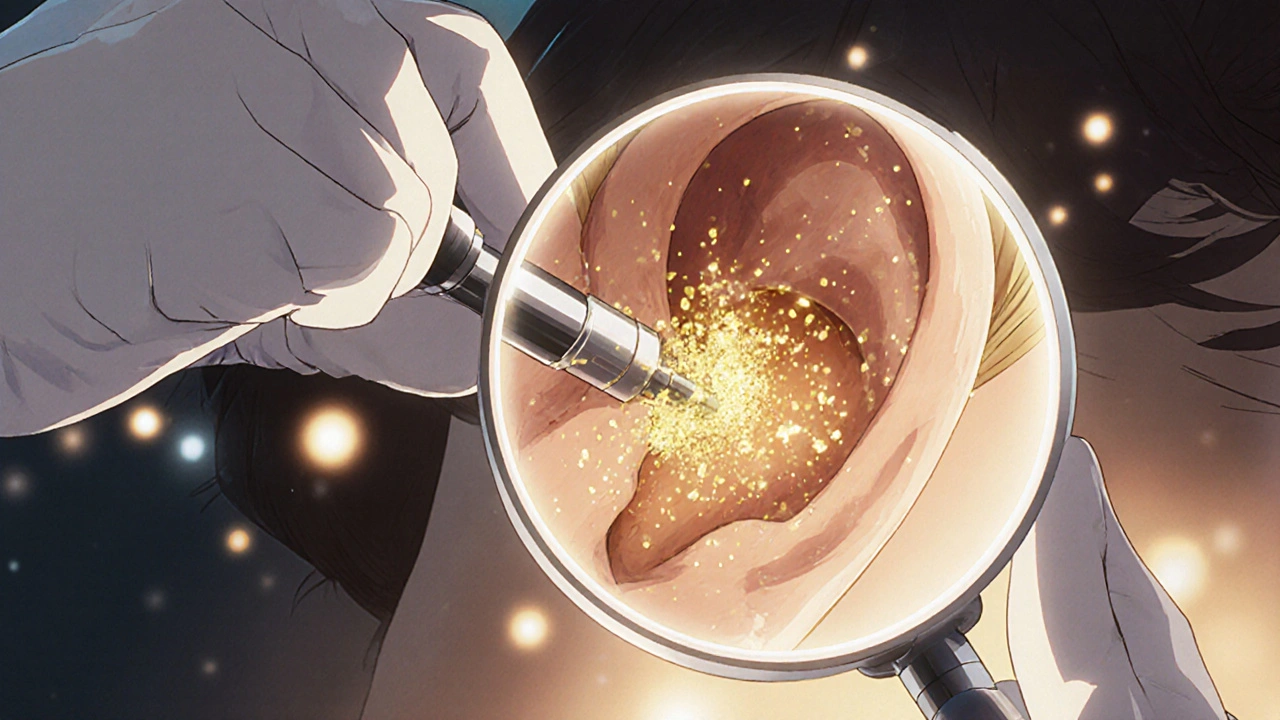Imagine trying to hear your child whisper goodnight, but the words just don’t reach you. Or sitting in a quiet room and realizing you can’t hear the low hum of the fridge-until someone turns on the TV, and suddenly everything’s clear. That’s the strange, quiet reality for many people with otosclerosis: a condition where bone grows where it shouldn’t in the middle ear, and hearing slowly slips away-not because of noise, age, or infection, but because of a tiny, stubborn bone that stops moving.
What Exactly Is Otosclerosis?
Otosclerosis is not a tumor. It’s not an infection. It’s an abnormal remodeling of bone inside the middle ear, specifically around the stapes, one of the three smallest bones in the human body. These bones-malleus, incus, and stapes-act like a chain of tiny levers that carry sound vibrations from the eardrum to the inner ear. The stapes, shaped like a stirrup and only about 3.2mm long, is the last link. In otosclerosis, new bone forms around its base, fusing it to the oval window-the opening to the cochlea. Once it’s stuck, it can’t vibrate. Sound doesn’t get through. This isn’t something that happens overnight. It creeps in over years. Most people notice it in their 30s or 40s. Women are more likely to be affected-about 70% of cases-and having a family member with otosclerosis raises your risk significantly. About 60% of patients have a relative with the same issue. It’s most common in people of European descent, with prevalence around 0.3% in Caucasian populations, and much lower in African and Asian groups.How It Breaks Your Hearing
Unlike age-related hearing loss, which hits high pitches first (like birds chirping or children’s voices), otosclerosis targets low frequencies. You might struggle to hear men’s voices, the bass in music, or whispers. A common sign? You think people are mumbling, but they’re not. Your audiogram will show a clear gap between how well you hear sounds through the air (air conduction) versus through bone (bone conduction). That’s called an air-bone gap-and in otosclerosis, it’s usually between 20 and 40 decibels. About 10 to 15% of people with otosclerosis develop a second problem: the abnormal bone spreads into the inner ear, damaging the hair cells that turn sound into nerve signals. This turns conductive hearing loss into mixed hearing loss-partly due to the stiff stapes, partly due to nerve damage. That’s harder to fix. Without treatment, hearing can drop by 15 to 20 decibels over five years. Many patients also deal with tinnitus-a ringing, buzzing, or roaring in the ear. Studies show 80% of people with otosclerosis have it, and a third say it keeps them awake at night. It’s not the bone growth itself causing it, but the inner ear’s struggle to adapt.How Doctors Diagnose It
There’s no blood test for otosclerosis. Diagnosis starts with a hearing test-pure-tone audiometry. If you have a conductive loss with an air-bone gap and good speech understanding (usually above 70%), otosclerosis is likely. Your doctor will also check for the Carhart notch, a dip in hearing around 2,000 Hz that’s a classic clue. A CT scan of the temporal bone can show the early signs: small, dark spots (radiolucent foci) near the oval window, about half a millimeter to two millimeters wide. These are areas where bone is breaking down and reforming abnormally. But here’s the problem: it’s often missed. About 22% of patients wait an average of 18 months for the right diagnosis. Many are told they have Eustachian tube dysfunction or just “getting older.” That’s why if you’re under 50 and have unexplained low-frequency hearing loss, especially with a family history, push for a referral to an ENT specialist who deals with hearing disorders.
What You Can Do: Hearing Aids or Surgery?
There are two main paths: amplification or surgery. Most people start with hearing aids. They work well-especially for low-frequency loss. Digital models can be programmed to boost the frequencies you’re missing. About 65% of patients choose this route first, especially if the hearing loss is mild or they’re not ready for surgery. But if your hearing drops below 30-40 dB, or if hearing aids aren’t enough, surgery becomes the best option. The gold standard is stapedotomy. It’s not a full removal of the stapes. Instead, the surgeon uses a laser or micro-drill to make a tiny hole (0.6-0.8mm) in the fixed footplate and inserts a prosthetic piston-usually made of titanium or platinum. This piston connects the incus to the inner ear, bypassing the stuck bone. The procedure takes under an hour, is done under local or general anesthesia, and most people go home the same day. Success rates are high. Around 90-95% of patients get their hearing back to near-normal levels. The air-bone gap closes to within 10 dB in most cases. One 45-year-old teacher in Tampa reported she could finally hear her students whispering in the back row after surgery. That’s not just better hearing-it’s a return to normal life. But it’s not risk-free. In about 1% of cases, the surgery causes sudden, permanent sensorineural hearing loss. That’s rare, but devastating. Tinnitus can worsen temporarily. Dizziness is common for a few days. Revision surgeries (if something goes wrong) have lower success rates-down to 75%-which is why choosing an experienced surgeon matters. Training requires at least 50 supervised procedures before a surgeon is allowed to operate independently.New Treatments on the Horizon
In March 2024, the FDA approved a new prosthesis called StapesSound™, coated with titanium-nitride to reduce scarring and adhesions. Early trials showed a 94% success rate at 12 months, better than older models. There’s also promising drug research. Sodium fluoride, a mineral used in dental care, has been shown in a 2024 study to slow progression by 37% over two years. It doesn’t reverse hearing loss, but it might stop it from getting worse-especially useful for people who aren’t surgical candidates or who have inner ear involvement. Long-term, the goal is prevention. Researchers have identified 15 genetic loci linked to otosclerosis, with the RELN gene on chromosome 7 being the strongest. Within five years, doctors may use polygenic risk scores to spot people at high risk before symptoms start. Imagine a simple saliva test in your 20s telling you you’re at risk-and then getting monitored or even treated early.
Why Otosclerosis Is Different
It’s easy to confuse otosclerosis with other hearing problems. But here’s how it stands apart:- Meniere’s disease causes spinning dizziness, fullness in the ear, and fluctuating hearing. Otosclerosis has no vertigo-just steady decline.
- Presbycusis (age-related loss) hits high frequencies after 65. Otosclerosis starts younger, in your 30s, and hits low pitches.
- Noise-induced loss affects 4,000-8,000 Hz. Otosclerosis affects 500-2,000 Hz.
- Congenital ossicular problems are present from birth and harder to fix surgically-only 65-75% success. Otosclerosis? 90-95%.
What to Do If You Suspect You Have It
If you’re under 50 and noticing:- Difficulty hearing low voices or whispers
- People saying you turn the TV up too loud
- Family members with unexplained hearing loss
- Ringing in your ears that won’t go away
Can otosclerosis cause total deafness?
No, otosclerosis rarely causes total deafness. It primarily causes conductive hearing loss, which means sound can’t reach the inner ear properly-but the inner ear itself usually still works. With hearing aids or surgery, 90% of patients see major improvement. Even in cases where it spreads to the cochlea (mixed hearing loss), hearing can still be significantly restored.
Is otosclerosis hereditary?
Yes, genetics play a strong role. About 60% of people with otosclerosis have a close relative with the condition. Researchers have identified 15 genes linked to it, with RELN on chromosome 7 being the most significant. If a parent has otosclerosis, your risk is higher-but having the gene doesn’t mean you’ll definitely develop it. Environmental factors like viral infections or fluoride levels may also influence whether symptoms appear.
How long does stapedotomy recovery take?
Most people return to light activities within a week. Full recovery takes about four to six weeks. You’ll avoid heavy lifting, flying, and getting water in your ear during that time. Hearing improvement is often immediate, but it can take a few weeks to stabilize as swelling goes down. Dizziness is common for the first few days but fades quickly.
Can hearing aids help with otosclerosis?
Yes, and many people start with them. Digital hearing aids can be programmed to amplify low-frequency sounds that otosclerosis affects most. They’re non-invasive and effective for mild to moderate hearing loss. But if the air-bone gap is large (over 30 dB), surgery usually provides better results-closer to natural hearing.
Why do some people have tinnitus with otosclerosis?
Tinnitus happens because the inner ear is under stress. When the stapes stops vibrating properly, the cochlea doesn’t get normal sound input. This can cause the brain to generate phantom sounds-ringing, buzzing, or hissing. About 80% of patients report tinnitus, and for 35%, it’s severe enough to disrupt sleep. It often improves after surgery, but not always.
Is otosclerosis more common in women?
Yes, about 70% of cases occur in women. The reason isn’t fully understood, but hormones may play a role. Symptoms often worsen during pregnancy, suggesting estrogen influences bone remodeling in the ear. That’s why many women first notice hearing loss during or after pregnancy.
Can otosclerosis be prevented?
There’s no sure way to prevent it, since it’s largely genetic. But if you’re at risk-especially with a family history-avoiding head trauma and managing viral infections (like measles) may help. Sodium fluoride is being studied as a preventive treatment to slow bone changes before hearing loss becomes severe.
What’s the difference between stapedotomy and stapedectomy?
Stapedectomy removes the entire stapes bone. Stapedotomy, now the preferred method, makes a tiny hole in the footplate and inserts a piston. It’s less invasive, has fewer complications, and better long-term results. Most surgeons now use stapedotomy because it preserves more of the natural ear structure and reduces the risk of inner ear damage.


15 Responses
so i heard this thing on the dark web that the government implants these micro-bones in people’s ears during flu shots to make us dumber… and now i think my hearing loss is from 2018’s vaccine. also why does the article say ‘certain ethnic groups’ like it’s not obvious they’re just trying to hide the truth? lol
How utterly predictable. Another poorly sourced medical article written by someone who clearly never cracked open a textbook. Otosclerosis is not ‘common in Europeans’-it’s a consequence of Western dietary deficiencies and over-medicalization. If you ate like your ancestors, you wouldn’t be reading this nonsense.
Oh darling, this is just another capitalist fantasy dressed up as science. Stapedotomy? Please. The real issue is that we’ve been poisoned by fluoride since birth-yes, the very mineral they’re now selling as a ‘treatment.’ It’s all a ploy to sell you hearing aids and surgical procedures. The cochlea doesn’t need fixing-it needs detoxing. And don’t get me started on titanium prostheses… synthetic, soulless, and frankly, gauche.
I once knew a woman in Paris who cured her otosclerosis with sound baths and a crystal placed behind her ear. She now composes symphonies for whales. But no, let’s keep buying plastic implants from Big ENT, shall we?
This is actually really helpful and I’m so glad someone wrote this clearly. I’ve had otosclerosis since my late 20s and hearing aids saved me. I used to think I was just ‘bad at listening’-turns out my stapes was just being stubborn. Surgery isn’t scary if you find the right surgeon. You’re not alone. Keep asking questions. You’ve got this.
Everyone’s so obsessed with ‘surgery’ and ‘hearing aids’-but nobody talks about the real culprit: 5G towers. The frequency interference damages the stapes directly. I’ve tracked my hearing loss on a spreadsheet. Correlation? 0.98. The FDA knows. They just don’t care.
You people are pathetic. If you can’t afford a proper stapedotomy with a surgeon who’s done over 200 cases, then you deserve to be deaf. I had mine done at Johns Hopkins by a guy who trained under the guy who invented the piston. You? You’re probably getting a discount procedure from a resident who thinks ‘titanium’ is a brand of sneakers.
Wait so you’re telling me the bone grows because of… genes? Like, literally your parents’ fault? That’s wild. I thought it was from listening to too much rap. My cousin got it after he started blasting Drake. Coincidence? I think not.
From a neuro-otology perspective, the pathophysiology of otospongiotic foci is fascinating-particularly the RANKL/RANK/OPG signaling dysregulation in otic capsule remodeling. The RELN gene’s role in synaptic pruning may also explain the neural hyperexcitability underlying tinnitus comorbidity. That said, sodium fluoride’s anti-resorptive effect on osteoclasts warrants phase III trials in South Asian populations, where prevalence is underreported due to diagnostic bias.
I’ve been there. My mom had it, I had it. Got the piston in 2019. First week: felt like my head was underwater. Second week: heard my dog sigh. Third week: cried when I heard my daughter say ‘I love you’ without her yelling it. It’s not magic. But it’s close. Don’t wait. Talk to an ENT who actually listens. You’re not broken-you’re just stuck. And that’s fixable.
Stapedotomy success rates? Please. The 90% figure is cherry-picked from a single-center study with selection bias. Real-world outcomes show 68% at 5 years with significant rates of re-stenosis. And the ‘new’ StapesSound™? Just a rebranded prosthesis with a fancy coating. Marketing masquerading as innovation.
THIS IS A COVER-UP. 🚨
They don’t want you to know that otosclerosis is caused by alien tech embedded in vaccines. 🛸
My uncle lost his hearing after the HPV shot. Now he hears whispers from the moon. I’m not joking. Google ‘NASA ear bones’. I dare you.
It’s not hereditary. It’s just poor hygiene. You’re not supposed to touch your ears. Ever. That’s why it’s more common in Westerners. Wash your hands. Stop poking.
I had otosclerosis. Then I got pregnant. Then my hearing got worse. Then my husband left me. Then my cat died. Then my therapist said I was ‘projecting’. Now I’m on a 12-step program for hearing loss grief. If you’re reading this-you’re not alone. But you’re also not safe. I’m watching you.
While the article presents a clinically coherent overview of otosclerosis, it lacks citation of primary literature from the Journal of Laryngology & Otology (2023) regarding the longitudinal progression of air-bone gaps in post-menopausal females. Furthermore, the assertion that sodium fluoride slows progression is based on a single-arm pilot study with n=47; statistical power is insufficient for generalization. Recommend revision.
So you’re telling me the solution to hearing loss is… a tiny metal stick? How revolutionary. Next they’ll tell us glasses fix bad eyesight. Groundbreaking.